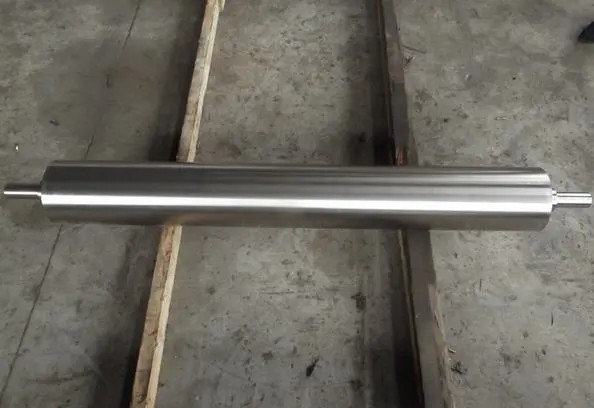Types of Stabilizer Rolls and Their Applications
Grooved Stabilizer Rolls
Grooved stabilizer rolls are characterized by their surface pattern of precisely machined channels. These grooves serve to create an air film between the roll and the material, effectively reducing friction and preventing wrinkles. The depth and spacing of these grooves can be customized to suit specific applications, making them versatile for various web materials and production speeds. Grooved stabilizer rolls are particularly effective in high-speed paper and film production lines where maintaining web stability is crucial for quality output.
Perforated Stabilizer Rolls
Perforated stabilizer rolls feature a series of small holes across their surface. These perforations allow for controlled air flow, creating a consistent air cushion that supports the web material. This design is especially beneficial for delicate or porous materials that require gentle handling. The size and pattern of perforations can be tailored to optimize performance for different material types and production requirements. Perforated rolls are often used in textile manufacturing and converting processes where material integrity is paramount.
Combination Stabilizer Rolls
Combination stabilizer rolls incorporate both grooves and perforations in their design. This hybrid approach offers the benefits of both types, providing enhanced stability and versatility. The combination of features allows for superior web control in complex manufacturing environments where multiple material types or varying production speeds are encountered. These rolls are often employed in advanced converting operations and specialty paper production where maximum flexibility and performance are required.
Advantages of Stabilizer Rolls Over Traditional Roll Types
Enhanced Web Stability
One of the primary advantages of stabilizer rolls over traditional roll types is their superior ability to maintain web stability. The air cushion created by the roll's design significantly reduces web flutter and vibration, even at high speeds. This stability is crucial for ensuring consistent quality in products such as paper, film, and textiles. Traditional smooth rolls, while effective for some applications, can struggle to maintain stability at higher speeds or with more delicate materials. The improved stability offered by stabilizer rolls translates to fewer defects, reduced waste, and increased production efficiency.
Reduced Material Damage
Stabilizer rolls are engineered to minimize direct contact between the roll surface and the web material. This reduction in physical contact significantly decreases the risk of material damage, such as scratches, tears, or deformations. Traditional rolls, which rely on direct contact for web control, can sometimes cause surface imperfections or structural damage to sensitive materials. By utilizing air flow to support and guide the web, stabilizer rolls provide a gentler handling solution, preserving the integrity of the material throughout the production process. This is particularly beneficial for high-value or delicate substrates where material quality is paramount.
Improved Process Control
The unique design of stabilizer rolls allows for more precise control over the web handling process. The ability to adjust air flow and pressure provides operators with additional parameters to fine-tune production settings. This level of control is not typically available with traditional roll types, which often rely solely on mechanical adjustments. The improved process control offered by stabilizer rolls enables manufacturers to optimize their production lines for specific materials and operating conditions, resulting in higher quality outputs and increased operational flexibility. Additionally, the consistent performance of stabilizer rolls contributes to more stable and predictable production processes, facilitating easier quality control and troubleshooting.
Maintenance and Longevity Considerations for Stabilizer Rolls
Regular Cleaning and Inspection
Maintaining the effectiveness of stabilizer rolls requires a consistent approach to cleaning and inspection. Unlike smooth rolls, which may only need occasional wiping, stabilizer rolls demand more attentive care due to their complex surface features. Regular cleaning is essential to prevent the accumulation of debris in grooves or perforations, which could impair the roll's performance. Inspection routines should focus on identifying any wear patterns, surface damage, or blockages in air passages. Implementing a scheduled maintenance program that includes thorough cleaning and detailed inspections can significantly extend the operational life of stabilizer rolls and ensure they continue to perform optimally.
Surface Refurbishment Techniques
Over time, the surface of stabilizer rolls may wear or become damaged, potentially compromising their effectiveness. However, unlike some traditional roll types that may need complete replacement, stabilizer rolls often benefit from refurbishment techniques. These can include re-grooving, re-perforating, or applying specialized coatings to restore or enhance performance. The ability to refurbish rather than replace not only extends the life of the roll but also provides opportunities to upgrade its characteristics to meet evolving production needs. This adaptability makes stabilizer rolls a more cost-effective long-term solution compared to conventional rolls that may have limited options for restoration.
Balancing and Alignment Considerations
Proper balancing and alignment are critical for the longevity and performance of all roll types, but they are particularly crucial for stabilizer rolls. The precision required in maintaining an even air cushion means that even slight imbalances or misalignments can have noticeable effects on web stability. Regular dynamic balancing checks and precise alignment procedures should be part of the maintenance routine for stabilizer rolls. Unlike simpler roll designs, stabilizer rolls may require specialized equipment and expertise for these procedures. Investing in proper balancing and alignment not only extends the life of the rolls but also ensures consistent production quality and reduces the risk of unexpected downtime due to roll-related issues.
In conclusion, stabilizer rolls offer significant advantages over traditional roll types in terms of web stability, material handling, and process control. Their unique design features, including grooves and perforations, enable them to create an air cushion that supports and guides web materials with minimal contact. This results in reduced damage, improved quality, and increased production efficiency across various industries. While stabilizer rolls may require more specialized maintenance, their longevity and adaptability make them a valuable investment for manufacturers seeking to optimize their production processes. For more information on stabilizer rolls and how they can benefit your specific application, please contact us at info@welongpost.com.




